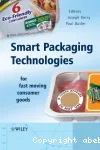1. Active Packaging of Food
1. Active Packaging of Food
+
-





